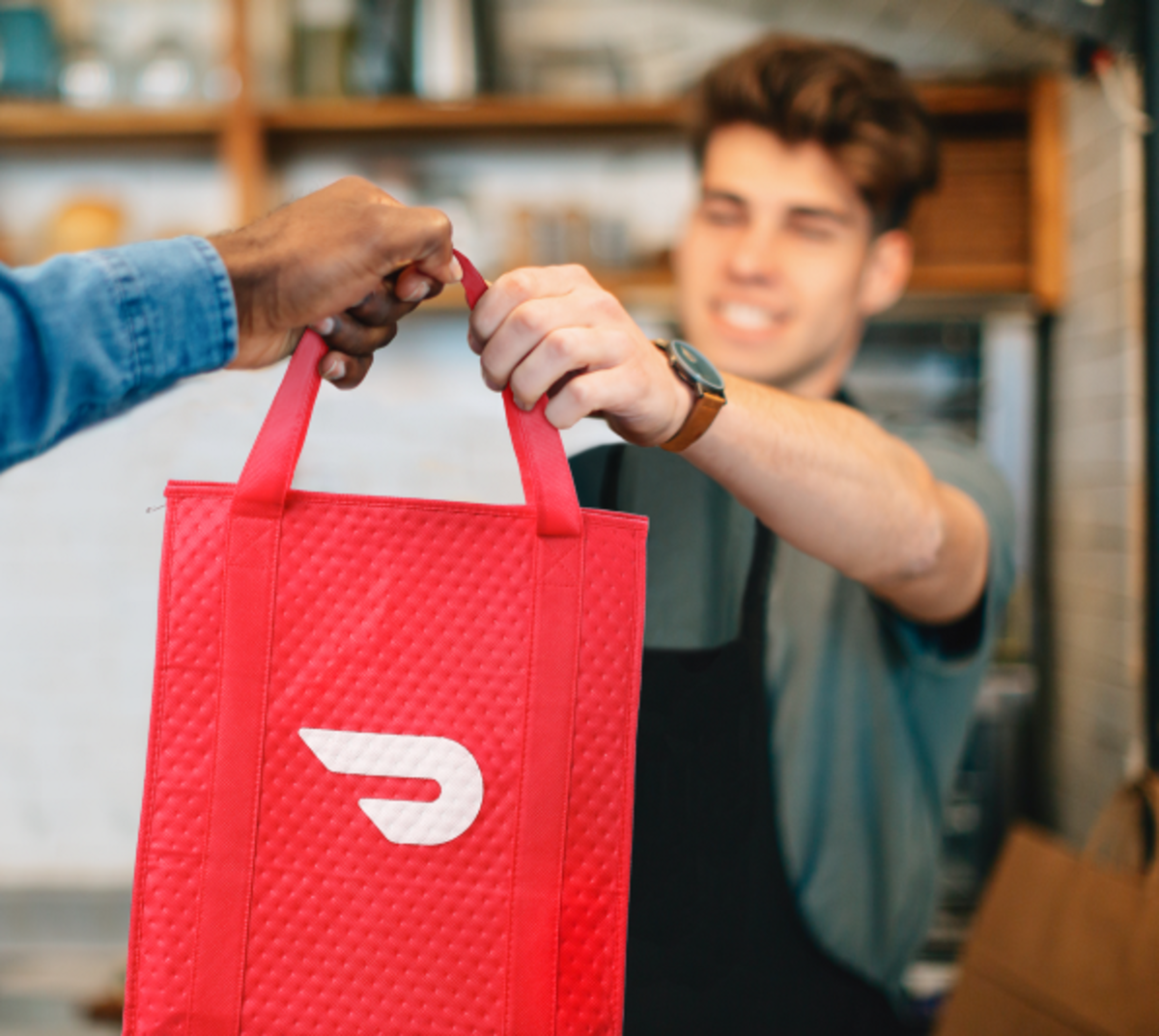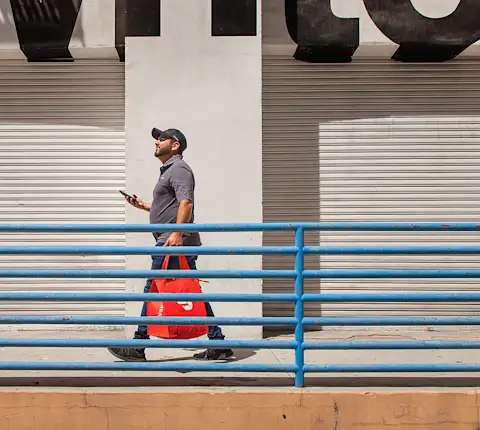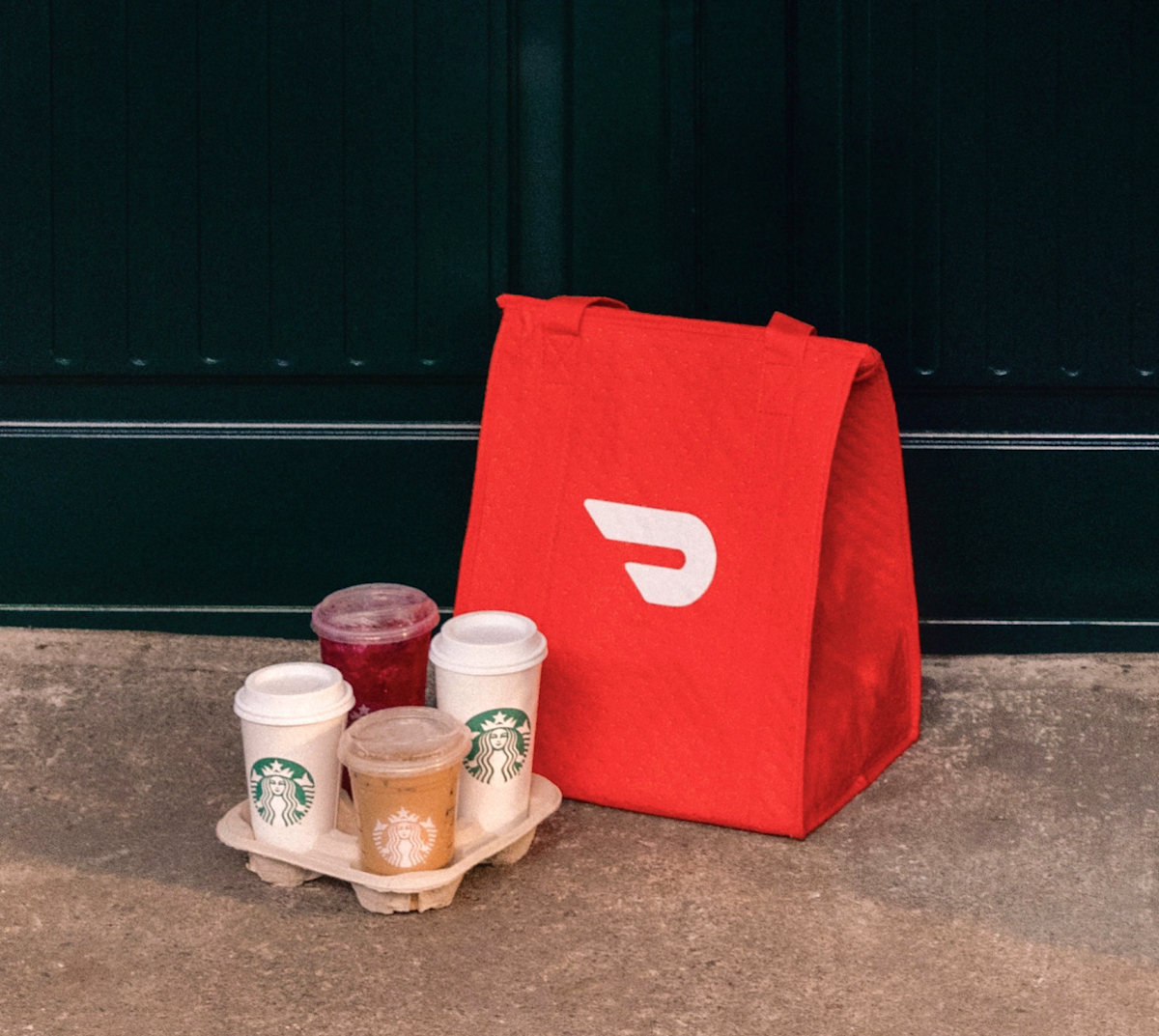While some restaurants have been handling their own pickup and delivery for years and are continuing to do that, others are tapping into third-party delivery platforms like DoorDash. Even before the pandemic, we knew every merchant has specific needs for their business, so we have worked hard to create products, tools, and services that meet those unique needs and enable us to deliver value to our entire community. We’ve created multiple paths to partner with DoorDash, including options that enable restaurants to accept orders from customers online, better showcase their restaurant to customers and potential customers, and get orders delivered – or almost any combination of those three. We also develop resources to help restaurants understand the incremental value our tools can bring them so they can make informed decisions. Our goal is to ensure merchants can choose what works best for them, logistically and financially.
That said, we know there have been questions and assumptions made about how third-party platforms like DoorDash work with restaurants. We’re eager to provide insight into how we structure our merchant agreements, what merchant fees cover, and how we want to work with cities to support the restaurant community.
How does DoorDash work with restaurants?
How we partner with restaurants begins with what a restaurant needs. Depending on the service the restaurant selects on the basis of their business needs, restaurants pay DoorDash a recurring monthly fee for software to accept online orders, a flat fee per order, or a percentage of the order total (known as a “commission”). We know this is a particularly challenging time for many restaurants, so we’ve reduced or even completely waived our fees on some of our services for many local, independent restaurants during this time.
Here’s how our different offerings – DoorDash Online Ordering, DoorDash Drive On-Demand, and the DoorDash Marketplace – work in practice:
Online Ordering: Earlier this year, we launched Online Ordering, which allows merchants to set up a branded online store enabling pickup and delivery directly from their website. This allows stores like Port of Peri Peri in Chicago to receive orders from customers already visiting their website. After adding Online Ordering, Port of Peri Peri experienced a 56% increase in orders.
Online Ordering is commission-free, and merchants can cancel at any time. We also know being able to accept orders online is more important than ever, which is why there are no activation, subscription, or merchant delivery fees on Online Ordering through March 2021 for restaurants with five or fewer locations in the United States and Canada.
Drive On-Demand: Merchants who would prefer to receive orders by phone or through their own app or website interface can still tap into our network for a flat fee per delivery through DoorDash Drive On-Demand. It enables merchants to request a driver anytime, track orders, streamline delivery costs, and drive incremental orders without having to invest in their own delivery fleet.
Marketplace: There are restaurants that prefer DoorDash to power their online ordering system, help them market themselves to customers, and arrange for the delivery of their orders. These restaurants work with DoorDash through our Marketplace, which connects restaurants with customers through our Dasher community. Customers can access restaurants conveniently, merchants benefit from increased exposure to customers, and Dashers earn income on each delivery.
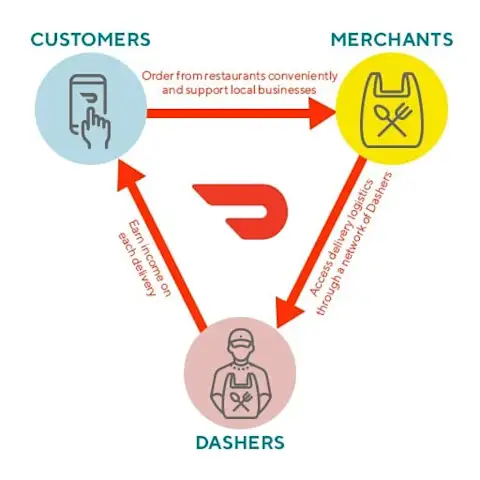
At a time when delivery has become an essential service, we’re proud that our Marketplace allows restaurants to continue operating, customers to continue safely ordering from, and supporting, their favorite neighborhood locations, and Dashers to earn when it works for them. 65% of customers say they tried a restaurant that they wouldn’t have otherwise because it was listed on DoorDash, and nearly two-thirds of restaurants say they were able to increase their profits during COVID-19 because of DoorDash. Since the first stay-at-home orders went into effect in mid-March through September, 1.9 million new Dashers joined the platform and together with existing Dashers earned more than $3.5 billion during the first six and a half months of the pandemic, with approximately 60% – $2.1 billion – of that total being earned by Dashers who live in zip codes with above average Black and/or Latinx representation. It’s an interconnected marketplace, and we’re proud of the value we bring to communities.
For our platform to succeed, it has to work for all of our users – merchants, Dashers, and customers. The fact is: delivery is cost-intensive. Many merchants didn’t offer delivery before partnering with DoorDash because hiring and paying drivers, purchasing insurance, and providing customer support is costly, especially when order volume can ebb and flow throughout the day, week, or year. For many restaurants, it just wasn’t workable. You’d have to be sure you had enough delivery drivers for your busiest night, but keep it affordable for your quietest afternoon. Instead, restaurants can partner with DoorDash, which manages all of those logistics and is inherently responsive to those changes because of our platform and Dasher community.
Our Marketplace offering is commission-based, but designed to allow restaurants to still choose what works best for them. For some, that can mean skipping delivery altogether through pickup or Self Delivery.
Pickup: Some restaurants and customers prefer to order online but have that order picked up in-person, which is why we offer the pickup option. Merchants can easily toggle between pickup and delivery, and since pickup orders don’t rely on our Dasher community, pickup orders always have a lower commission.
Self-Delivery: There are times, especially during the pandemic, that a restaurant may need help generating more orders in order to better utilize their in-house delivery team. With Self-Delivery, restaurants can meet new customers through the DoorDash Marketplace, but fulfill those orders with their own delivery fleet, all for a reduced commission.
For other restaurants, access to our full marketplace means they can rely on DoorDash for all the logistics, support, and marketing tools they need to meet customers online and grow their business. We’re proud to offer many options because restaurants need many options. We’ll continue to roll out new products that speak to what our partners need most.
What is a commission?
Simply put, a commission is a percentage of a Marketplace order subtotal that covers the various services and products merchants can access through DoorDash.
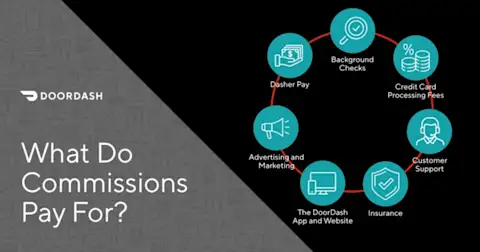
Specifically, commissions pay for:
Dasher Pay. Dashers made on average more than $22 per active hour nationally including tips, as of September 2020.
Background Checks. Dashers undergo secure, professional background checks which include a Criminal History Report and a Motor Vehicle Report.
Credit card processing fees. These can be as high as 3% of the order subtotal and are set by the processors.Customer Support. DoorDash works with thousands of customer support agents who respond to requests and questions from customers, merchants, and Dashers. This may include a Dasher who has a question about a payment, a customer who is asking about an extra item received, and a merchant who is asking about updating their menu in the DoorDash app.
Insurance. Dashers are automatically enrolled in third-party auto insurance policies, as well as insurance to cover medical and disability costs for on-the-job injuries. In addition, commissions cover DoorDash’s commercial insurance and more.
Advertising and marketing. When you open the DoorDash app, you notice certain restaurants are prominently displayed, others are eligible for DashPass, and some restaurants offer limited-time discounts. These are all marketing solutions for merchants looking to better reach customers. Commissions also cover DoorDash’s own advertising and marketing efforts that help drive more customers and Dashers to our platform, which strengthen the merchant experience, too. While marketing programs vary, our data shows that restaurants on average see 30% sales uplift from opting into these programs but they are completely optional when working with DoorDash.The DoorDash App and Website. The DoorDash website and mobile application are perhaps the most important product we provide. Through these interfaces, DoorDash has powered hundreds of millions of deliveries. We work hard to continually update and strengthen our technology in order to bring the best experience to merchants, Dashers, and customers.
How much is a commission?
While Online Ordering and Drive On-Demand orders involve flat fees per delivery order or payment processing, as opposed to a commission, for many restaurants, the best path to get online is by being on the DoorDash marketplace where they can have increased visibility to customers using the DoorDash app and website. For restaurants that choose to work with DoorDash through our marketplace, their agreement involves a commission. Commissions vary by restaurant and are agreed upon individually based on the product or the level of service. This means there is no blanket rate applied to all restaurants on our platform. There are many reasons – all entirely optional for the restaurant – that a commission may be different for different restaurants, but the biggest is marketing efforts.
DashPass, our subscription service, offers unlimited deliveries from thousands of eligible restaurants with $0 delivery fees and reduced service fees.* Since subscribers are more likely to select a DashPass eligible restaurant, opting in to DashPass is a great way for a restaurant to market themselves further to boost sales. As of late September of this year, there were 5 million DashPass customers. DashPass customers are more likely to order from participating restaurants, so signing up for DashPass is a great way for restaurants to boost orders.
Additional customer marketing tools like First Order, $0 Delivery Fee which can boost sales for a restaurant 25-30% over a given period of time. First Order, 20% Off and Order Again & Save, are some of the other options that can help restaurants meet and retain customers.
What’s the impact of commission caps?
Over the last few months, we’ve seen a number of jurisdictions debate and pass price controls – or what some have called “commission caps” – which limit the amount that restaurants can choose to pay in exchange for services from third-party delivery platforms. These efforts ultimately restrict restaurant choice, precisely when restaurants need the full range of options to help their businesses survive and thrive. We agree that restaurants need to be supported, now more than ever, which is why we offer so many services and products for restaurant partners. We hear from our partners that having choice with how to leverage our platform is critical. And that’s why limiting the options at restaurants’ disposal isn’t the answer.
“I’m the CEO and Founder of a proudly Black-owned restaurant. Without DoorDash, I wouldn’t be able to reach as many customers and increase awareness of my business, especially during this time. The commission on my orders enables me to tap into DoorDash’s customer base and operate a delivery function that would be near-impossible to do on my own. It also gives me the flexibility to scale up those services if I need to down the line. Capping the commissions would take that choice away from me and threaten my ability to adapt to the ever-changing COVID situation, which is why I strongly oppose this proposal.” – William Bonhorst, CEO & Founder, Man vs. Fries
Because of the range of costs that we have to cover for delivery, when a government jurisdiction imposes price controls, it may cause us to increase the fees we charge to consumers. Increasing costs for customers could lead to fewer orders, which reduces business for restaurants and work opportunities for Dashers.
Looking Ahead
One of the biggest issues with capping commission rates is the one-size-fits-all approach that doesn’t account for individual restaurant needs. As we’ve outlined here, merchant agreements aren’t one-size-fits-all so this blunt approach has numerous detrimental effects, including limiting choice for merchants who need it most, especially during this time.
As we continue to evolve our offerings to support merchants in various ways, such as Online Ordering and Drive On-Demand, we are also eager to engage with policymakers to support restaurants. We partnered with elected leaders to announce a grant program to help restaurants in select cities as winter approached, advocate for the RESTAURANTS Act, made a $200 million Main Street Strong Pledge, and continue conversations about ways cities can help get customers online. We also believe there is more to be done:
We urge all elected officials, community groups, and restaurants to contact their legislators to continue to advocate for the RESTAURANTS Act, which seeks to establish a $120 billion Revitalization Fund for independent restaurants across the United States.
Cities and states can support local restaurants by waiving fees, allowing restaurants to expand their outdoor seating capacity, and where funds are available, creating grant programs to help the hardest-hit restaurants. We look forward to expanding our own grant program from an initial commitment of $2 million to $10 million and will be proud to partner with cities across the United States and Canada.
Elected officials can continue to urge their communities to support local businesses. We have sought to do so through our #OpenForDelivery campaign, and this awareness is more important than ever as the impact of the pandemic grows.
This work is ongoing – both for DoorDash, and for the cities we live in. We’re eager to work together with all stakeholders to increase understanding of DoorDash’s services and merchant needs in order to find solutions that serve Dashers, customers, and restaurants.
* Applies to orders over $12. An order minimum of $10 applies in the following areas: Bakersfield (CA), Charlotte (NC), Cincinnati (OH), Dallas (TX), Denver/Boulder (CO), Indianapolis (IN), Los Angeles (CA), Orange County (CA), Phoenix (AZ), Sacramento (CA), Salt Lake City (UT), Tulsa (AZ).
